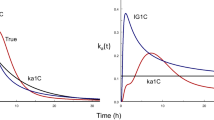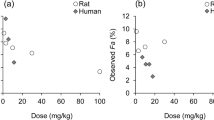Abstract
Purpose
To predict the absolute oral bioavailabilities (BAs) of drugs in humans without using pharmacokinetic data from intravenous administration in humans.
Methods
The distribution volume of the terminal phase (\({\text{Vd}}_{\beta } \)) in humans was predicted by three methods using animal pharmacokinetic data. Then, total body clearance (CLtot) was calculated by multiplying the elimination rate constant and \({\text{Vd}}_{\beta } \), and the BA was calculated as a ratio between CLtot and oral clearance. The predicted and observed values were compared for 67 drugs for which pharmacokinetic data after intravenous administration in humans were available.
Results
For \({\text{Vd}}_{\beta } \), predicted values within twice the observed value were obtained for 72.1% of drugs by both methods Ia and Ib, respectively, in which only rat pharmacokinetic data were used. The corresponding percentage was 75.0% for method II, in which pharmacokinetic data from animals other than rats were used. For BA, predicted values within 1.3 times the observed values were obtained for 66.7% and 57.4% of drugs by methods Ia and Ib, respectively, and 75.0% by method II.
Conclusions
Using the present methods, it is possible to predict BA from human oral administration data combined with animal pharmacokinetic data to a certain level without using intravenous injection data.





Similar content being viewed by others
Abbreviations
- β :
-
elimination rate constant in the terminal phase
- AUCiv :
-
area under the plasma concentration–time curve after intravenous administration
- AUCpo :
-
area under the plasma concentration–time curve after oral administration
- BA:
-
bioavailability
- CLpo :
-
oral clearance
- CLtot :
-
total body clearance
- f P :
-
free fraction in plasma
- f T :
-
free fraction in tissue
- Hc:
-
hematocrit value
- R B :
-
blood-to-plasma concentration ratio
- R E/I :
-
ratio of amount of the binding protein in the extracellular fluid to that in plasma
- V B :
-
volume of blood
- Vdβ :
-
distribution volume of the terminal phase
- Vdss :
-
distribution volume at steady state
- V E :
-
volume of extracellular fluid outside the plasma
- V T :
-
volume of tissue (except blood cells)
- V T/f T :
-
volume of distribution for the unbound drug
References
Dedrick RL, Bischoff KB, Zaharko DS. Inter-species correlation of plasma concentration history of methotrexate. Cancer Chemother 1 1970;52:95–101.
Boxenbaum H. Interspecies scaling, allometry, physiological time, and the ground plan of pharmacokinetics. J Pharmacokin Biopharm 1982;10:201–27.
Rane A, Wilkinson GW, Shand DG. Prediction of hepatic extraction ratio from in vitro measurement of intrinsic clearance. J Pharmcol Exp Ther 1977;200:420–4.
Roberts SM, Rowland M. Correlation between in vitro microsomal enzyme activity and whole organ hepatic elimination kinetics: analysis with a dispersion model. J Pharm Pharmcol 1985;38:177–81.
Ito K, Houston JB. Comparison of the use of liver models for predicting drug clearance using in vitro kinetic data from hepatic microsomes and isolated hepatocytes. Pharm Res 2004;21:785–92.
Iwatsubo T, Hirota N, Ooie T, Suzuki H, Sugiyama Y. Prediction of in vivo drug disposition from in vitro data based on physiological pharmacokinetics (review). Biopharm Drug Dispos 1996;17:273–310.
Lave T, Coassolo P, Reigner BG. Prediction of hepatic metabolic clearance based on interspecies scaling techniques and in vitro–in vivo correlations. Clin Pharmcokinet 1999;36:211–31.
Izumi T, Enomoto S, Hoshiyama K, Sasahara K, Shibukawa A, Nakagawa T, et al. Prediction of the human pharmacokinetics of triglitazone, a new and extensively metabolized antidiabetic agent, after oral administration, with an animal scale-up approach. J Pharmacol Exp Ther 1996;277:1630–41.
Obach RS, Baxter JG, Liston TE, Silber BM, Jones BC, Macintyre F, et al. The prediction of human pharmacokinetic parameters from preclinical and in vitro metabolism data. J Pharmacol Exp Ther 1997;283:46–58.
Sawada Y, Hanano M, Sugiyama Y, Harashima H, Iga T. Prediction of the volumes of distribution of basic drugs in humans based on data from animals. J Pharmacokinet Biopharm 1984;12:587–96.
Prothero JW. Scaling of blood parameters in mammals. Comp Biochem Physiol 1980;67A:649–57.
Benowitz N, Forsyth RP, Melmon KL, Rowland M. Lidocaine disposition kinetics in monkey and man I. Prediction by a perfusion model. Clin Pharmacol Ther 1974;16:87.
Greens DS, Quintiliani R, Nightingale CH. Physiological perfusion model for cephalosporin antibiotics 1: model selection based on blood drug concentrations. J Pharm Sci 1978;67:191.
Sawada Y, Hanano M, Sugiyama Y, Iga T. Prediction of the disposition of b-lactam antibiotics in humans from pharmacokinetic parameters in animals. J Pharmacokinet Biopharm 1984;12:241–61.
Sugita O, Sawada Y, Sugiyama Y, Iga T, Hanano M. Effect of sulfaphenazole on tolbutamide distribution in rabbits. Analysis of interspecies difference in tissue distribution of tolbutamide. J Pharm Sci 1984;73:631–4.
Sawada Y, Hanano M, Sugiyama Y, Iga T. Prediction of the disposition of nine weakly acidic and six weakly basic drugs in human from pharmacokinetic parameters in rats. J Pharmacokin Biopharm 1985;13:477–92.
Author information
Authors and Affiliations
Corresponding author
Electronic supplementary material
Below is the link to the electronic supplementary material.
Supplementary Table
(XLS 453 kb)
Rights and permissions
About this article
Cite this article
Imawaka, H., Ito, K., Kitamura, Y. et al. Prediction of Human Bioavailability from Human Oral Administration Data and Animal Pharmacokinetic Data Without Data from Intravenous Administration of Drugs in Humans. Pharm Res 26, 1881–1889 (2009). https://doi.org/10.1007/s11095-009-9902-6
Received:
Accepted:
Published:
Issue Date:
DOI: https://doi.org/10.1007/s11095-009-9902-6




